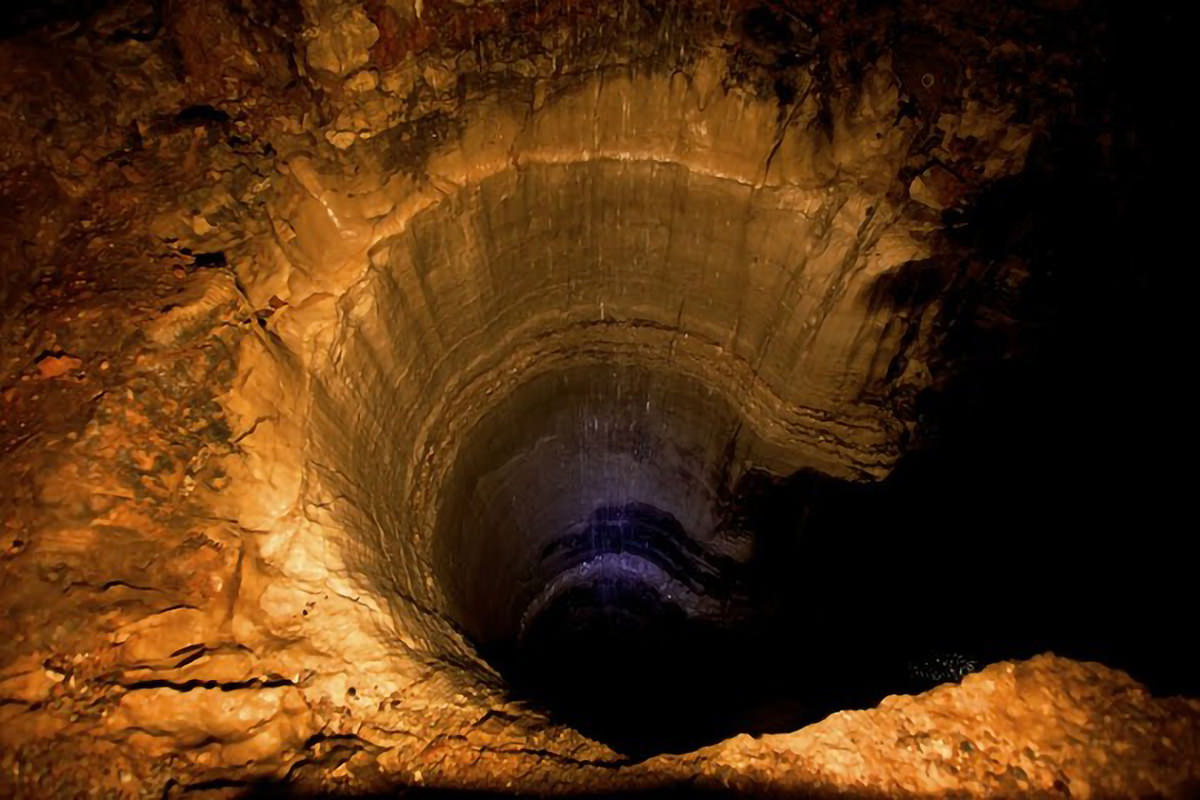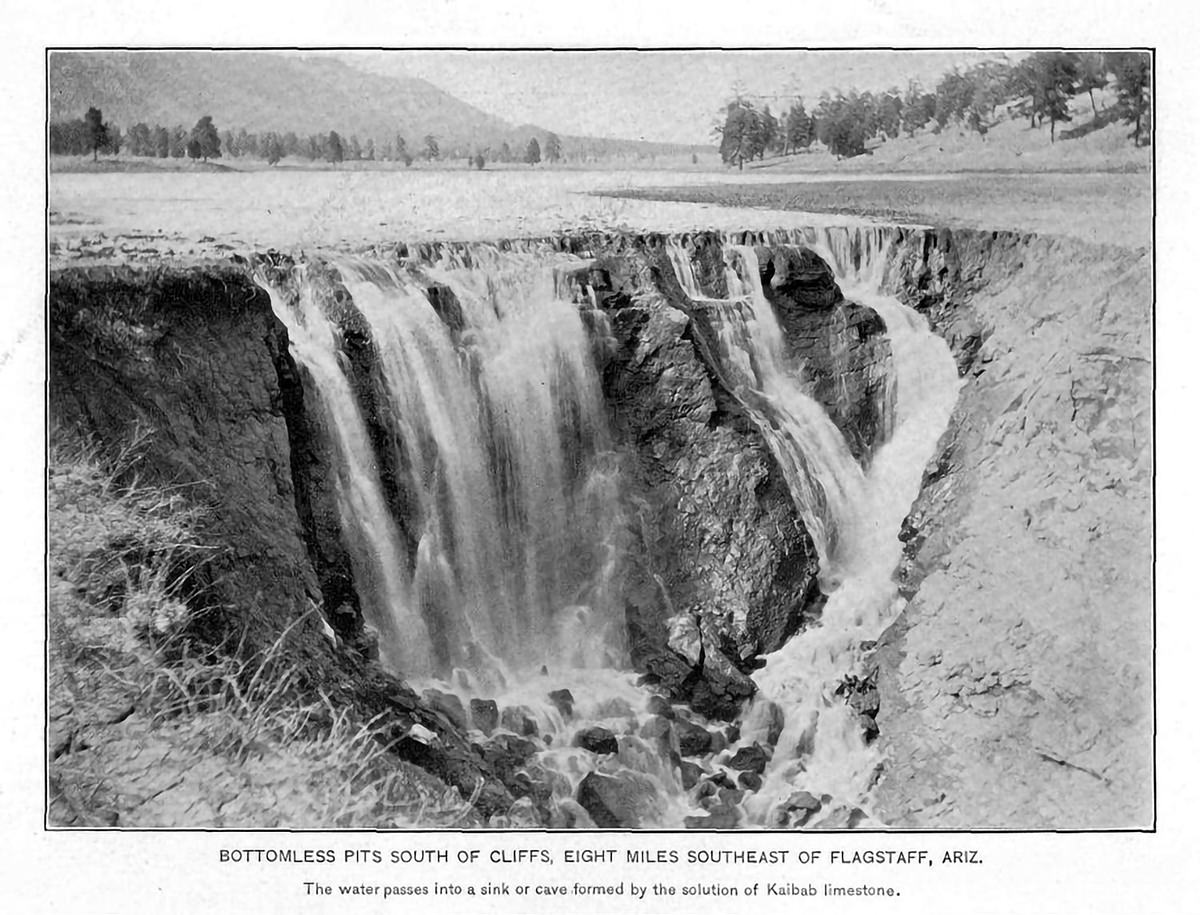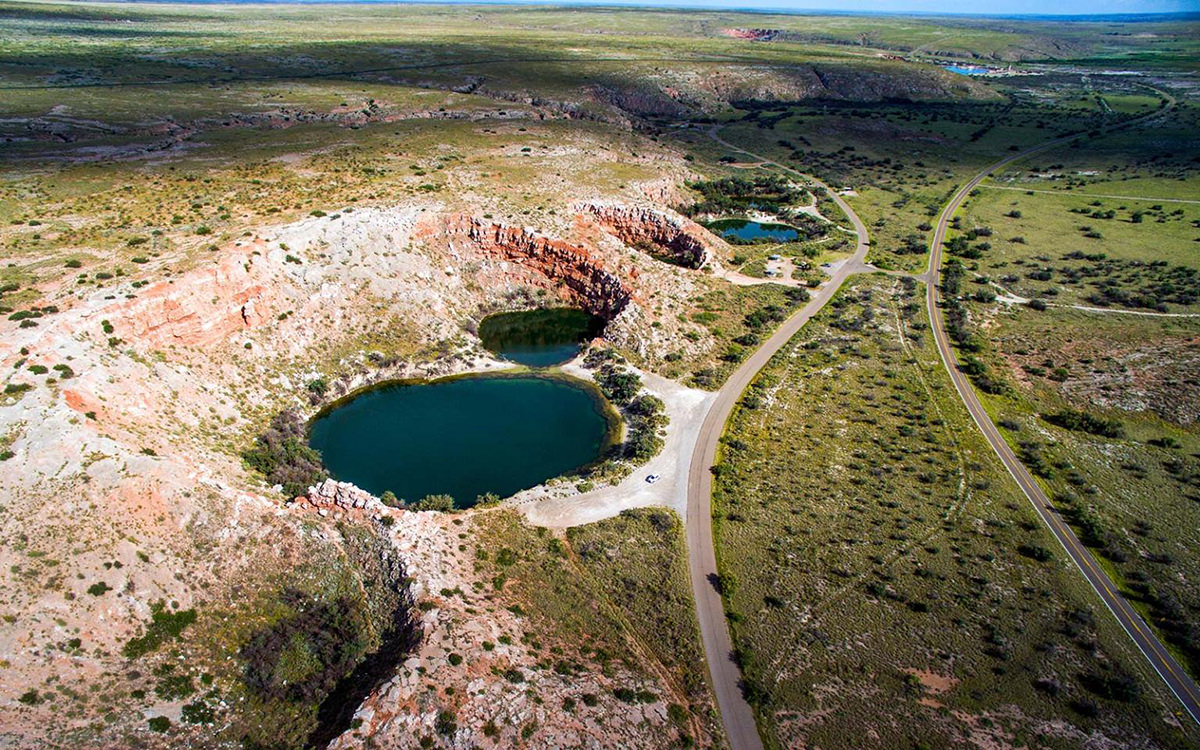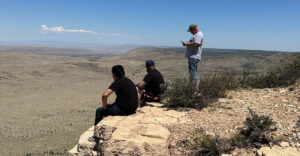There are countless holes in the ground. Some have water. Some are just open void and darkness. The most important thing one might ask about a hole is how deep it is. When we can’t readily discern the depth, the hole begets additional legendary characteristics.

The dark hole is universally scary. Whatever is down there is unknown but undoubtedly unpleasant. The light cannot penetrate far into the gloom so the bottom can’t be seen. Thus, people assume it has no bottom at all. Objects thrown into the hole aren’t recovered. The listener may hear no splash or crack of a stone hitting some surface below. As a folklore motif, the unfathomable hole is ancient. There are countless tales of bottomless lakes, pools, and bogs. These water bodies claim people (dead or alive), animals, treasure, transport vehicles, and many secrets. Like quicksand, the bottomless pit has also become a media horror trope. If you don’t die from the sheer bottomlessness of it all, you will encounter whatever nasty thing exists in the dark, forsaken void.
They are used as a handy disposal method, a perfect death trap, and sometimes, for the villain’s demise in a dramatic last scene. It’s impossible to discuss the bottomless pit or pool without its connection to hell. To fall into the “pit” is symbolic of the descent into hell and damnation.
Therefore, it might not be surprising to discover how often legendary bottomless holes have a demonstrated bottom that people simply chose to ignore. Having a bottom doesn’t necessarily make it less dangerous or negate its evil reputation that is mythologized via various themes. In this feature, I explore these folklore themes utilized widely for local holes, pools and lakes to mark their cultural significance. And, I try to connect them to their geological foundations.
Folklore
In a practical sense, bottomless simply means someone tried to detect the bottom and couldn’t. Naturally, locals would be concerned about the depth of an open hole or pool that they might fall into. They would logically attempt to plumb it with an available oar or long tree branch or sapling. Others will try a weighted line. If those methods fail, then, seemingly by default, the opening is declared “bottomless”. Hundreds, perhaps thousands of openings and water bodies were said at one time or another to be “bottomless”. Legends live on even into modern times.
The bottomless pit is a well-known supernatural trope that frequently includes additional features such as having bizarre inhabitants, emitting strange sounds, or having supernatural properties.
William Corliss, a collector of anomalies wrote that the accounts of such pits “smack of sensationalism and must be taken with several grains of salt”. Mike Dash suggests that the widespread legend of bottomless holes and lakes was an indicator of “the limits of geographical mobility a century or more ago”. That is, people didn’t travel so their yardstick for a big hole was that one in their vicinity. Some water bodies eventually have dried up enough to lose the mystique.
More creatively, some people thought that a water body without a discernible depth had at on its floor an outlet or tunnel to another water body, sometimes hundreds of miles away. Even if a lake had a measured floor, it was common to see mentioned a cave passage that existed somewhere within the perimeter that was where the true danger or mystery was. Swimmers were warned that an icy cold swell or sucking whirlpool would imperil them.

Geological Origins
The term “bottomless” has been applied to open dry holes, and water-filled depressions like lakes, ponds, pools, or bogs. There must be thousands of examples of features around the world that have been at one time called “bottomless”. Their geological origins are diverse.
Mammoth cave in Kentucky has a “bottomless pit” that is 105 feet deep. It can be difficult to measure a true “bottom” if a cavern extends into a deeper karst system. Some caves or shafts are rumored to drop off into a huge cavern. That is usually more fiction than reality.
The Dozmary Pool in Bodmin Moor, Cornwall was said to have an outlet to the sea which was 10.5 miles (16.9 km) away. Dozmary Pool is important for migrating birds, native rare plants, and for its preservation of vegetation since the last ice age. But it was also claimed to possibly be the location where the legendary King Arthur received the sword Excalibur from the Lady of the Lake. Several other tales are also associated with the pool including that it was the source of the winds on the moor. The lake dried up in 1866 and again in 1869 and 1976 proving that it was not bottomless but subject to drought conditions.
Vouliagmeni is a lake in Greece that was said to suck people in via a whirlpool, or they could be nabbed by the evil fairy folk living at the bottom. The lake had formed from a cavern roof collapse after an earthquake some 2000 years ago. No one had managed to sound the bottom because it was part of an extensive cave system that continued under the mountain. Some people trying to explore the underwater caves have perished. It’s possible that a strong current might have existed underwater at times, creating a visible swirling effect.
As with some of the “bottomless lakes” waterless chasms are often karst-related sinkholes or caves. Flagstaff, Arizona’s Bottomless Pit is a karst feature. As with many sinkholes, it connects to and drains into the underground openings. Filling a sinkhole often doesn’t work because the fill material collapses into a bigger opening. When the hole gets blocked it may temporarily hold water until the plug comes loose and the hole drains. There are many legends around this Flagstaff pit and it was once somewhat of a tourist attraction.
Bottomless Lakes State Park in New Mexico is over 1600 acres of land with eight lakes available to visitors. They acquired their name when local herdsmen could not discern the bottom via ropes. The green-blue color from algae makes the pools look tranquil and ultra-deep. Bottomless Lakes are the result of karst features, sinkholes that are perpetually filled with water because they extend below the water table. These features are called cenotes and are not uncommon. The legend of the lakes includes the idea that the lakes are connected to each other and to Carlsbad Caverns (90 miles away) or the Gulf of Mexico (600 miles away) through subterranean passages. While this is not technically impossible for water pathway via a regional aquifer, it is NOT remotely plausible for objects of any size, like an animal or person. Again, we see the idea of a “sucking” current that could capture swimmers. The Bottomless Lakes has resident monsters described as giant turtles.

Can They Exist?
There are a few reasons why bottomless holes or lakes can’t exist. For a start, how would a bottomless hole hold water?
A truly bottomless hole would go through the earth and come out the other side — an impossibility to create and a physical conundrum in terms of “falling” into it. The physics of such a hole is quite weird. After about 20 hrs of falling, you’d reach the center of the earth, but then get stuck in the core — trapped in the gravitational center. If there were no air in the hole, however, things would go MUCH faster.
Could we create a bottomless hole? No. We have a really hard time creating a super-deep hole because it needs to be reinforced and cooled. Eventually, equipment fails at the pressure and heat at about 12 kilometers. The Kola Superdeep Borehole is the deepest hole on earth at 40,230 feet. Started in 1970, the drilling of this hole in the Kola peninsula of Russia, near the Norway border was shut down in 1992. The goal was to study the lower crust. Interesting mineralogical and even biological data were collected. An oil well in Qatar achieved a longer borehole length at 40,320 feet (but did not exceed the Kola reach in depth below sea level) in 2008.
The deepest natural pits in the world include the Devil’s Sinkhole, Rocksprings, Texas at 400’ and Dean’s Blue Hole, Long Island, Bahamas at 650’. Mining created the Chuquicamata Copper Mine, in Chile at 2,790’, the Kimberley Mine in South Africa at 700’ and the Berkeley Pit, in Butte, Montana at 1700’. Lake Baikal in Russia is the world’s deepest lake. Located in a rift valley, the average depth is over 2000 feet with the maximum depth measured at 5,387 feet. The deepest spot in the ocean is 35,814 feet below sea level, part of the Mariana Trench between Guam and the Philippines called the Challenger Deep.
Bottomless Holes Are Part of the Enchanted Landscape
Clearly, “bottomless” is not a term to be taken literally. It represents something dark, spooky, and unnatural.
There aren’t many explanations for the claims of bottomless holes. The most obvious is that people exaggerated the depth or outright lied about the claim. Encountering karst openings may have definitely led to people believing they found a bottomless hole. Even today, some people remain imaginative enough to think that they found some secret military project, an ancient city or even evidence of a Hollow Earth. More recently, mysterious holes are endowed with speculative suggestions that they are wormholes or entrances to another dimension. It’s also pretty fun to imagine they are the gaping mouth of a subterranean creature or that the earth itself is a living thing that would eat us. The bottomlessness of the various pits, lakes and bogs worldwide is not physically accurate but the concept of the unknown abyss is an essential feature of a mythological and enchanted landscape.
Article written by Sharon A. Hill and originally published on SpookyGeology.com.












